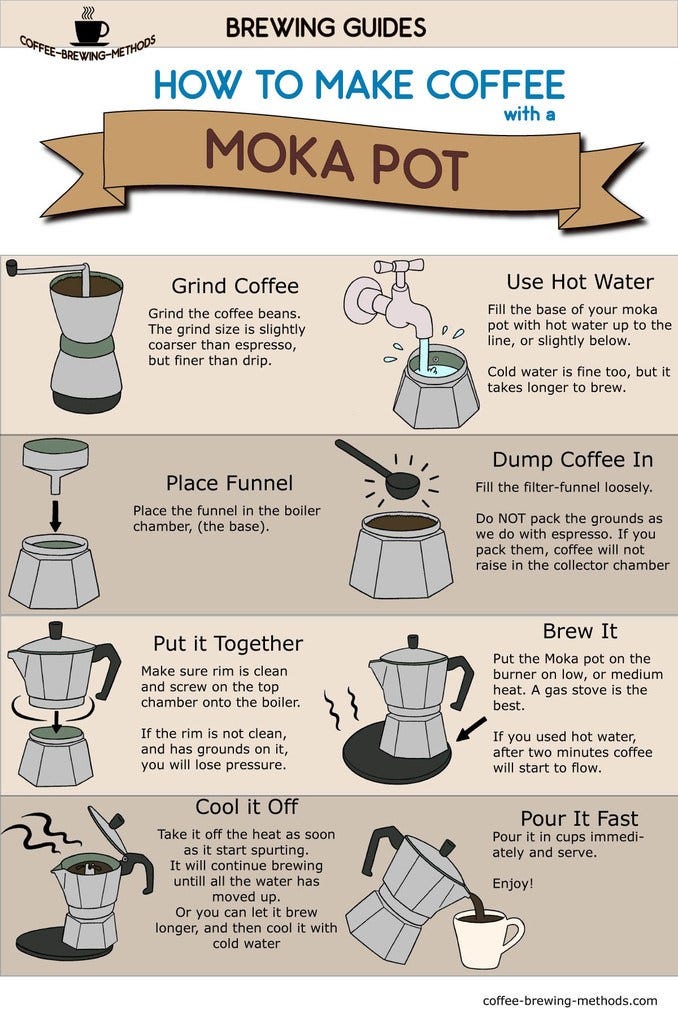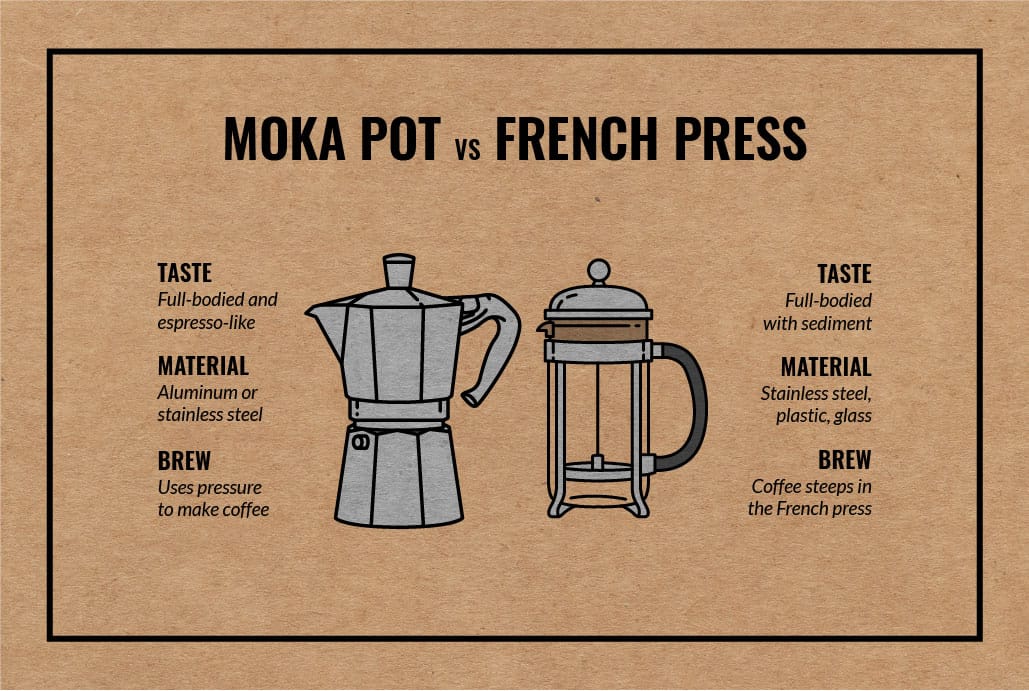As an Amazon Associate CoffeeXplore.com earns from qualifying purchases.
Do Moka Pots Make Good Coffee? Taste, Strength, and How It Compares to Espresso
Moka pots have been brewing rich, full-bodied coffee for nearly a century, captivating coffee enthusiasts with their unique blend of simplicity and flavor. But do these iconic stovetop brewers truly deliver on their promise of exceptional coffee? Let’s dive into the world of Moka pots and uncover the secrets behind their enduring popularity.
Key Facts:
– Moka pots were invented in 1933 by Alfonso Bialetti in Italy
– They use pressure to force hot water through ground coffee
– Moka pots produce a stronger brew than drip coffee, but less intense than espresso
– The classic Bialetti Moka Express remains a bestseller worldwide
– Proper technique is crucial for achieving optimal flavor with a Moka pot
What is a Moka Pot?
A Moka pot is a stovetop coffee maker that uses steam pressure to brew coffee. Invented in 1933 by Italian engineer Alfonso Bialetti, this iconic device has become a staple in kitchens around the world. Its distinctive octagonal shape and aluminum construction have remained largely unchanged since its inception, a testament to its timeless design and functionality.

A classic Moka pot ready to brew – source
How Does a Moka Pot Work?
The Moka pot’s brewing process is a fascinating interplay of physics and chemistry. Here’s a step-by-step breakdown of how this clever device works:
- Water Chamber: The bottom chamber is filled with cold water.
- Coffee Basket: Ground coffee is placed in a filter basket in the middle.
- Upper Chamber: An empty top chamber is screwed onto the base.
- Heat Application: The pot is placed on a heat source.
- Pressure Build-up: As the water heats, pressure increases in the lower chamber.
- Extraction: Hot water is forced up through the coffee grounds and into the upper chamber.
- Collection: The brewed coffee collects in the top chamber, ready to be served.
This unique brewing method results in a strong, concentrated coffee that sits somewhere between drip coffee and espresso in terms of intensity and flavor profile.
The Moka Pot’s Place in Coffee Culture
The Moka pot holds a special place in coffee culture, particularly in Italy where it originated. Its affordability and ease of use made it a household staple, earning it the nickname “la macchinetta” (the little machine). Today, the Moka pot remains a beloved brewing method for coffee enthusiasts worldwide, prized for its ability to produce rich, full-bodied coffee without the need for expensive equipment.
Do Moka Pots Make Good Coffee?
The question of whether Moka pots make good coffee is subjective and depends on personal preferences. However, many coffee lovers swear by the unique flavor profile and brewing experience that Moka pots offer.
Flavor Profile of Moka Pot Coffee
Moka pot coffee is known for its bold, rich flavor and full body. The brewing process extracts more oils and dissolved solids than drip coffee, resulting in a more concentrated brew. This leads to a flavor profile that’s often described as:
- Intense: Stronger than drip coffee, but less concentrated than espresso
- Full-bodied: A heavier mouthfeel compared to other brewing methods
- Complex: Capable of highlighting both bright and dark notes in coffee beans
Many coffee enthusiasts appreciate the Moka pot’s ability to produce a strong cup of coffee that doesn’t sacrifice flavor complexity. As James Hoffmann, World Barista Champion and coffee expert, notes:
“Moka pots can produce a delicious, strong cup of coffee with a unique character that sits between filter coffee and espresso.”
Moka Pot vs. Other Brewing Methods
To truly understand the quality of Moka pot coffee, it’s helpful to compare it to other popular brewing methods:
| Brewing Method | Strength | Body | Flavor Complexity | Ease of Use |
|---|---|---|---|---|
| Moka Pot | High | Full | High | Moderate |
| Drip Coffee | Medium | Light | Medium | Easy |
| French Press | Medium | Full | High | Easy |
| Espresso | Very High | Full | Very High | Difficult |
As we can see, Moka pots offer a unique combination of strength, body, and flavor complexity that sets them apart from other brewing methods.
Factors Affecting Moka Pot Coffee Quality
While Moka pots are capable of producing excellent coffee, the quality of the brew depends on several factors:
- Coffee Grind: The grind size should be slightly coarser than espresso but finer than drip coffee.
- Water Quality: Using filtered water can significantly improve the taste.
- Heat Control: Proper heat management is crucial to avoid over-extraction and bitterness.
- Maintenance: Regular cleaning and proper care of the Moka pot ensure consistent quality.
By mastering these variables, you can consistently brew delicious coffee with your Moka pot.
Tips for Making the Best Moka Pot Coffee
To help you get the most out of your Moka pot, here are some expert tips for brewing the perfect cup:
- Use Freshly Ground Coffee: For the best flavor, grind your beans just before brewing.
- Don’t Overfill or Tamp: Fill the basket with coffee, but don’t pack it down.
- Start with Hot Water: This reduces brewing time and helps avoid over-extraction.
- Keep the Heat Low: A gentle, steady heat produces the best results.
- Remove from Heat Early: Take the pot off the heat when you hear a gurgling sound.

The Moka pot brewing process in action – source
For a detailed guide on perfecting your Moka pot technique, check out this comprehensive video tutorial.
Common Moka Pot Issues and Solutions
Even experienced Moka pot users can encounter issues. Here are some common problems and how to solve them:
Why Is My Moka Pot Leaking?
Leaks can occur for several reasons:
- Improper Assembly: Ensure all parts are correctly aligned and tightly screwed together.
- Damaged Gasket: Replace the rubber gasket if it’s worn or damaged.
- Overfilling: Don’t fill the water chamber above the safety valve.
How to Reduce Bitterness in Moka Pot Coffee
If your Moka pot coffee tastes bitter, try these solutions:
- Use a coarser grind
- Reduce the heat
- Remove the pot from heat earlier
- Try pre-infusing the coffee grounds with a small amount of hot water before brewing
The Environmental Impact of Moka Pots
In today’s eco-conscious world, it’s worth considering the environmental impact of our coffee brewing methods. Moka pots offer several advantages in this regard:
- Durability: A well-maintained Moka pot can last for decades, reducing waste.
- No Paper Filters: Unlike drip coffee makers, Moka pots don’t require disposable filters.
- Energy Efficient: They use less energy than electric coffee makers or espresso machines.
These factors make Moka pots a relatively sustainable choice for environmentally-conscious coffee lovers.
FAQs About Do Moka Pots Make Good Coffee:
Q: What is the best grind size for Moka pot coffee?
A: The best grind size for Moka pot coffee is medium-fine, slightly coarser than espresso but finer than drip coffee. This grind size allows for optimal extraction without clogging the filter or causing over-extraction.
Q: How long does it take to brew coffee with a Moka pot?
A: Brewing coffee with a Moka pot typically takes about 5-10 minutes. The exact time can vary depending on factors such as heat intensity, water temperature, and the size of the pot.
Q: Can I use a Moka pot for espresso?
A: While Moka pots produce a strong, concentrated coffee, it’s not technically espresso. Moka pot coffee lacks the crema and high pressure (9 bars) required for true espresso. However, it can be used as a base for espresso-style drinks.
Q: How do I clean a Moka pot?
A: To clean a Moka pot, disassemble it and rinse all parts with hot water. Avoid using soap as it can affect the flavor of future brews. Dry thoroughly before reassembling. For deep cleaning, use a mixture of water and vinegar occasionally.
Q: Is Moka pot coffee stronger than drip coffee?
A: Yes, Moka pot coffee is generally stronger than drip coffee. The pressure brewing method extracts more oils and dissolved solids, resulting in a more concentrated brew with a fuller body and intense flavor.
Summary:
Moka pots have earned their place in coffee culture by consistently delivering rich, full-bodied brews that satisfy coffee enthusiasts worldwide. While they may not produce true espresso, Moka pots offer a unique brewing experience that bridges the gap between drip coffee and espresso machines. The quality of Moka pot coffee largely depends on technique and attention to detail, but when done right, it can rival more expensive brewing methods.
From its storied history to its eco-friendly attributes, the Moka pot continues to charm coffee lovers with its simplicity and reliability. Whether you’re a seasoned barista or a curious beginner, exploring the world of Moka pot brewing can open up new dimensions in your coffee journey. So, do Moka pots make good coffee? With the right approach and a little practice, they can make excellent coffee that’s uniquely satisfying.
As you embark on your Moka pot adventure, remember that the joy of coffee lies not just in the final cup, but in the process of brewing itself. Experiment with different beans, grinds, and techniques to find your perfect brew. After all, the best coffee is the one that brings you the most pleasure.

